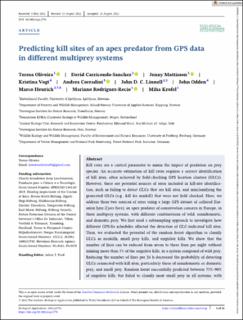| dc.contributor.author | Oliveira, Teresa | |
| dc.contributor.author | Sanchez, David Carricondo | |
| dc.contributor.author | Mattisson, Jenny | |
| dc.contributor.author | Vogt, Kristina | |
| dc.contributor.author | Corradini, Andrea | |
| dc.contributor.author | Linnell, John Durrus | |
| dc.contributor.author | Odden, John | |
| dc.contributor.author | Heurich, Marco Dietmar | |
| dc.contributor.author | Rodríguez-Recio, Mariano | |
| dc.contributor.author | Krofel, Miha | |
| dc.coverage.spatial | Europe | en_US |
| dc.date.accessioned | 2023-01-16T11:28:13Z | |
| dc.date.available | 2023-01-16T11:28:13Z | |
| dc.date.issued | 2022 | |
| dc.identifier.issn | 1051-0761 | |
| dc.identifier.uri | https://hdl.handle.net/11250/3043676 | |
| dc.description.abstract | Kill rates are a central parameter to assess the impact of predation on prey species. An accurate estimation of kill rates requires a correct identification of kill sites, often achieved by field-checking GPS location clusters (GLCs). However, there are potential sources of error included in kill-site identification, such as failing to detect GLCs that are kill sites, and misclassifying the generated GLCs (e.g., kill for nonkill) that were not field checked. Here, we address these two sources of error using a large GPS dataset of collared Eurasian lynx (Lynx lynx), an apex predator of conservation concern in Europe, in three multiprey systems, with different combinations of wild, semidomestic, and domestic prey. We first used a subsampling approach to investigate how different GPS-fix schedules affected the detection of GLC-indicated kill sites. Then, we evaluated the potential of the random forest algorithm to classify GLCs as nonkills, small prey kills, and ungulate kills. We show that the number of fixes can be reduced from seven to three fixes per night without missing more than 5% of the ungulate kills, in a system composed of wild prey. Reducing the number of fixes per 24 h decreased the probability of detecting GLCs connected with kill sites, particularly those of semidomestic or domestic prey, and small prey. Random forest successfully predicted between 73%–90% of ungulate kills, but failed to classify most small prey in all systems, with sensitivity (true positive rate) lower than 65%. Additionally, removing domestic prey improved the algorithm's overall accuracy. We provide a set of recommendations for studies focusing on kill-site detection that can be considered for other large carnivore species in addition to the Eurasian lynx. We recommend caution when working in systems including domestic prey, as the odds of underestimating kill rates are higher. | en_US |
| dc.language.iso | eng | en_US |
| dc.rights | Navngivelse 4.0 Internasjonal | * |
| dc.rights.uri | http://creativecommons.org/licenses/by/4.0/deed.no | * |
| dc.subject | domestic prey | en_US |
| dc.subject | Eurasian lynx | en_US |
| dc.subject | GPS location clusters (GLCs) | en_US |
| dc.subject | GPS-fix schedule | en_US |
| dc.subject | kill sites | en_US |
| dc.subject | multiprey system | en_US |
| dc.subject | random forest | en_US |
| dc.title | Predicting kill sites of an apex predator from GPS data in different multi-prey systems | en_US |
| dc.type | Peer reviewed | en_US |
| dc.type | Journal article | |
| dc.description.version | publishedVersion | en_US |
| dc.rights.holder | © 2022 The Authors | en_US |
| dc.subject.nsi | VDP::Matematikk og Naturvitenskap: 400::Zoologiske og botaniske fag: 480 | en_US |
| dc.source.pagenumber | 12. | en_US |
| dc.source.journal | Ecological Applications | en_US |
| dc.identifier.doi | 10.1002/eap.2778 | |
| dc.identifier.cristin | 2087726 | |
| dc.relation.project | Norges forskningsråd: 251112 | en_US |
| dc.relation.project | Norges forskningsråd: 281092 | en_US |
| dc.relation.project | Norges forskningsråd: 160022/F40 | en_US |
| dc.relation.project | Nature Protection Division of the County Governor’s Office for Innlandet | en_US |
| dc.relation.project | Nature Protection Division of the County Governor’s Office for Viken | en_US |
| dc.relation.project | Nature Protection Division of the County Governor’s Office for Vestfold & Telemark | en_US |
| dc.relation.project | Nature Protection Division of the County Governor’s Office for Trøndelag | en_US |
| dc.relation.project | Nature Protection Division of the County Governor’s Office for Nordland | en_US |
| dc.relation.project | Nature Protection Division of the County Governor’s Office for Troms & Finnmark | en_US |
| dc.relation.project | Slovenian Research Agency: Grant/Award Numbers: N1-0163, P4-0059 | en_US |
| dc.relation.project | Andre: Charity foundation from Liechtenstein | en_US |
| dc.relation.project | Andre: Fundaç˜ao para a Ciência e a Tecnologia | en_US |
| dc.relation.project | ndre: Hunting inspectorate of the Canton of Bern | en_US |
| dc.relation.project | Andre: Stotzer-Kästli-Stiftung, Zigerli- Hegi-Stiftung, Haldimann-Stiftung, Zürcher Tierschutz, Temperatio-Stiftung, Karl Mayer Stiftung, Stiftung Ormella | en_US |
| dc.source.articlenumber | e2778 | en_US |

